#vivian norbury
Text
Mary is able to notice, react to, and jump in front of the bullet in the time that elapses after Vivian Norbury fires her gun and before it hits Sherlock, because in this universe bullets travel at approximately the speed of a Galapagos tortoise
64 notes
·
View notes
Text
Woke up this morning to a bunch of notifications on my very old post celebrating Vivian Norbury as an awesome and stylish character/villain... How nice to see a minor character getting some love!
Oh no, it's actually just a bunch of talking about how great she is for killing Mary.
What the fucking fuck.
#i thought i had blocked all the Mary haters years ago#but i guess we've sprouted some new ones#well that ruined my whole mood#original post
6 notes
·
View notes
Note
Hey Steph! Happy holidays if you celebrate or happy whatever if you don't care! My request is pretty easy I guess but I'm terribile at using the ao3 filter (its totally me, I'm "new" to fandom fanfics and stuff). I'm looking for a fic where Sherlock or John or both have covid! Thanks xoxo
Hey Nonny!
Thank you! I don't really do Christmas these days, but I do appreciate the sentiment.
Ah, I do have a list of Quarantine / Lockdown / Pandemic (MFL’s) fics, @sherlockedcarmilla has an Isolated Johnlock Fic Recs Collection, and there's a COVID-19 Fic Recs by SwissMiss
I have these specific fics on my MFL list, tagged specifically with COVID / Coronavirus. Enjoy! And as usual, please add your own, friends!
COVID-19/CORONAVIRUS FICS (MFLs)
End of the Curve by doctor_not_your_girlfriend(T, 833 w., 1 Ch. || COVID-19, One Shot, Medical Realism, Major Illness, Recovery, Optimism, Disability, Needles) – July, 2021. Mycroft has a special delivery for Sherlock. Inspired by Proving A Point by elldotsee, J_Baillier.
The Unexpected Threat by J_Baillier (T, 4,283 w., 1 Ch. || Military AU / Pacific Rim Fusion || Established Relationship, Medical Conditions, Coronaviruses, Doctor John, Bratty Sherlock, Romance, Science Fiction, Futuristic Medicine, Ghost Drifting AKA Telepathy, Medical Hurt/Comfort, Sexual Healing) – The kaiju are not the only threat to the security and well-being of the staff of PPDC's Chard's Rift base. It's the year 2050, and a coronavirus epidemic sweeping the planet has reached The Azores. Part 4 of the At The Edge of Our Hope
a hands-off approach by OmalleyMeetsTibbs and simplyclockwork (E, 7,516 w., 1 Ch. || Background Mystrade, Coronavirus / COVID-19, Quarantine, Developing Relationship, Alternating POV, Love Confessions, First Kiss/Time, Bratty Sherlock, Touch Starvation, Friends to Lovers, Bisexual John, Everyone Ships It, Awkward Romance, Idiots in Love) – Quarantine is a time of reflection, a time of adapting, a time of finding connection through other means.And throwing sticky hands at your touch-starved flatmate. OR “How to comfort your touch-starved consulting detective during COVID: a guide by John Watson.”
Am I the Current (Tiger) King of England? by Dee_Laundry (T, 9,360 w., 1 Ch. || Tiger King Fusion || Post-S4, Dreams, Friendship, John’s Sexuality, Sherlock’s Sexuality, Quarantine/CoVID-19, Past Character Death, Mentions of Violence, Mentions of Dom/Sub, First Kiss) – “I had the weirdest dream last night,” John said. Seven times.
The Secret of Hazel Grange by SilentAuror(E, 18,153 w., 1 Ch. || Post S4, Christmas, COVID-19 / Pandemic, POV Sherlock) – John has a secret, and Sherlock is bothered. Trapped together at Baker Street during the lockdown, the tension only grows worse as Christmas draws nearer...
Lockdown by johnwatso and Salambo06(E, 23,376 w., 20 Ch. || Quarantine, COVID-19, Lockdown, Fluff, Parentlock, Reunion, Dancing, Soft Idiots, Sex Toys) – The world is in lockdown due to Covid-19. This is how Sherlock and John spend their time.
Inhale With Ease by Vulpesmellifera (E, 25,989 w., 8 Ch. || S4 Divergence, Covid-19/Quarantine, Jealous John, Love Letters, Victor Trevor, Divorce, Angst with Happy Ending) – In the years after Vivian Norbury's capture, life seems to work out just as John planned. He's got that respectable job at the surgery and goes home to his wife and child. He joins Sherlock on cases a couple times per week. It's a rhythm he can live with - just enough adrenaline highs to balance out the drudgery of a normal bloke's life. Until a pandemic, and Victor Trevor, arrive in London.
Quarantine by wendymarlowe (T, 53,950 w., 200 Ch. || PODFIC AVAILABLE || Coronavirus / Quarantine, John’s Blog, Asexual Sherlock, Slow Burn, Epistolary, Developing Relationship, Real Time, Case Fic) – John and Sherlock are stuck at 221B together due to coronavirus concerns. Sherlock slowly drives John barmy. [TRANSLATIONS: Русский]
#steph replies#johnlock fic recs#coronavirus#covid 19#pandemic fics#quarantine fics#my fic recs#to read
38 notes
·
View notes
Text
LUCY & THE JOANS!
Lucille Ball’s Collabs with Women Named Joan

A remarkable number of talented women named Joan - and even a few memorable characters - were part of the Lucyverse.

JOAN BANKS (1918-1989)
Joan Banks’ only credit with Lucille Ball was in “Fan Magazine Interview” (1954) in which she played reporter Eleanor Harris, assigned to do a story on Ricky Ricardo’s wife aka Lucy Ricardo. Here character name was a tribute to real-life writer Eleanor Harris.

JOAN BLONDELL (1906-1979)
Joan Blondell (sister of Gloria Blondell) was active as a performer concurrently with Lucille Ball. On “The Lucy Show,” she played Joan Brenner, a character intended to fill the gap after the departure of Vivian Vance. But she did not get along with Lucille Ball, and after a shouting match in front of the studio audience, Blondell was dismissed after just two episodes.

JOAN CAREY (1921-2015)
Joan Carey was born Joan Somerville Norbury on February 18, 1921 in Yorkshire, England. As a background performer and stand-in, she appeared on many episodes of “I Love Lucy” and “The Lucy Show,” generally uncredited.
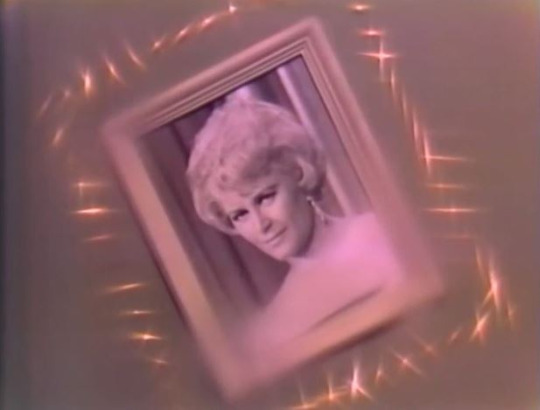
JOAN CAULFIELD (1922-1991)
Joan Caulfield played the role of Liz Cooper on the television adaptation of “My Favorite Husband” (1953-55). Lucille Ball played the role on radio, but chose instead to play Lucy Ricardo. Caulfield and Ball were later both guest stars on “Bob Hope’s Leading Ladies” in 1966.

JOAN CRAWFORD (1905-1977)
Joan Crawford was born Lucille Fay LeSueur. The Oscar-winning actress was mentioned on several episodes of “I Love Lucy” and “The Lucy Show” before making a guest appearance in “Lucy and the Lost Star” in 1968. The episode was originally intended for Gloria Swanson, hence the non-specific title. The title “Lucy and Joan” had already been used when Joan Bennet guest-starred. As with Bennett there was off-stage friction between Crawford and Ball.

JOAN COLLINS (1933)
English-born actress Joan Collins hosted the “All Star Party for Lucille Ball” in 1984. She was also seen with Ball on “Bob Hope’s Leading Ladies” (1966), “Women I Love: Beautiful But Funny” (1982), “Night of 100 Stars II” (1985), and “Friar’s Club Tribute to Gene Kelly” (1985).

JOAN CROSBY (1924-1992)
Joan Crosby was a journalist who wrote about Lucille Ball and was the one-time president of the Hollywood Women’s Press Club. As such, she played herself (above far right) in “Lucy Meets the Burtons” (1970).

JOAN FONTAINE (1917-2013)
Born Joan de Beauvoir de Havilland in Tokyo, she was the sister of Olivia de Havilland. She appeared with Lucy (and two other Joans) in “Bob Hope’s Leading Ladies” (1966). In 1959 she appeared on an episode of “Westinghouse-Desilu Playhouse” hosted by Desi Arnaz.
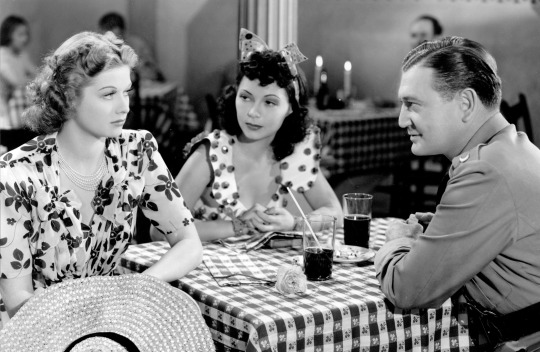
JOAN GRANT
Joan Grant is the character played by Lucille Ball in The Marines Fly High (1940). She runs a cocoa plantation in the South American jungle and allows a platoon of US Marines to stay there. Two of the Marines tussle over her affections. When she is kidnapped, the two Marines unite to save her.
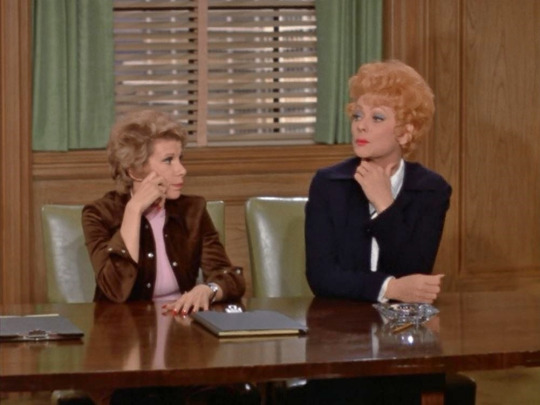
JOAN RIVERS (1933-2014)
Joan Alexandra Molinsky was born in New York City and became one of the top female comedians of all time. She co-starred with Lucille Ball on “Here’s Lucy” in “Lucy and Joan Rivers Do Jury Duty” (1973) where Rivers played Joan Reynolds. She was the first female guest-host of "The Tonight Show” interviewing Lucille Ball three times.

JOAN SWIFT (1933-2016)
Joan Swift was a frequent background player who had a few lines on “The Lucy Show” and “Here’s Lucy.” Three of her characters were also named Joan. Her final screen appearance was in “Lucy Gets Lucky” (1975).

During her long career in Hollywood, Lucille Ball also worked with or employed Joan Benny (Jack’s daughter), Joan Marshall (”Star Trek”), Joan O’Brien (”Shower of Stars”), Joan Fairfax (”Tonight Show with Jack Paar”), Joan Staley (”The Untouchables”), and Joan Woodbury (”There Goes My Girl”).
BONUS JOANS

JOAN OF ARC (1412-1431)
In “Lucy the Skydiver” (1970), Lucy Carter hears the voices of strong women like Florence Nightingale and Joan of Arc, the Americanized name of the French saint and warrior Jeanne d'Arc.
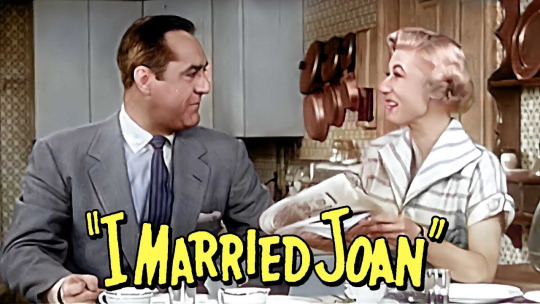
"I MARRIED JOAN” starring JOAN DAVIS
From 1952 to 1955 Joan Davis (1912-1961) starred in the sitcom “I Married Joan,” which was NBC’s answer to the popularity of “I Love Lucy.” Comic actress Davis had appeared with Lucille Ball in the 1933 film Bunker Bean. Like Lucy, Davis used her own first name and was a scatterbrained housewife. Her husband (Jim Backus) was a judge. Both shows featured Mary Jane Croft, Bobby Jellison, Shirley Mitchell, Sandra Gould, Margie Liszt, Jerry Hausner, Elvia Allman, Myra Marsh, Phil Arnold, Dick Elliott, Robert Foulk, Joseph Kearns, Maxine Semon, Don Brodie, Hal March, Richard Reeves, Herb Vigran, Norman Varden, Harry Bartell, Kay Wiley, Charlotte Lawrence, Frank Nelson, Frank Gerstle, Vivvi Janis, George Neise, Ross Elliott, Verna Felton, Fritz Feld, Mabel Paige, Rolfe Sedan, Paul Dubov, Maurice Marsac, Peter Leeds, Shepard Menken, Strother Martin, Junie Ellis, Florence Bates, Sam Hearn, Mary Treen, and Hans Moebus. Like Lucille Ball, Joan Davis also served as Executive Producer of her series, which, like “I Love Lucy,” was filmed at General Service Studios.
#Joan#Lucille Ball#Joan Crawford#I Love Lucy#The Lucy Show#Here's Lucy#I Married Joan#Joan Davis#Joan of Arc#Joan Blondell#Joan Rivers#Joan Swift#Joan Fontaine#Joan Crosby#Joan Banks#Vivian Vance#Joan Carey#Gale Gordon#Joan Caulfield#John Collins#TV
2 notes
·
View notes
Text
We’re worth it, Chapter 11, July 4th
Previous chapters can be found here.
This chapter lines up with Here be Dragons Chapter 13 (prior to Molly’s individual session at the end of the chapter)
“Sorry about that, I had a – ” June started to apologize for the delayed start to their session.
“I know that Sherlock needs to take responsibility for his choice to go back to using, but he was not the only one who made mistakes and there were things that I said and didn’t say that need to be acknowledged.” Molly had barely waited for June to close the door to her office before the words were out of her mouth.
June smiled warmly at her. “I agree that everyone needs to take responsibility for the actions…do you want to sit down before we get into it?” She motioned to the empty chair next to Sherlock as Molly was still standing by the door.
Molly shook her head and walked over to the window, wrapping her arms around her small baby bump as she looked out. Sherlock stared at her from his seat with deep concern, but June looked at him and mouthed that it was okay, and he relaxed a bit.
“Sherlock, why don’t you start with how your week went?” she prompted. He continued to stare at Molly for a moment longer before blinking and clearing his throat.
“Well,” he said looking back at June, “I had a new case and went to my therapy session and Mina came with me to the lab for an afternoon.”
“Sounds like you had a good week.” He nodded in response. She turned back to Molly who was still staring out the window. “It sounds like you might have spent most of the week in your own head, Molly.”
She sighed and dropped her head down for a moment before turning around and looking at June. “At least most of the time that I was alone.”
“Since it sounds like you are ready to jump in, why don’t we just start there?” She gave Molly the floor to speak.
She nodded and walked to her chair, sitting down, taking a deep breath. “When Sherlock told me last week that it wasn’t my fault that he dove back into using, I felt like we were just going to push past my role in this and I didn’t want that to happen.”
“And what part of your role in this is bothering you?”
Molly furrowed her brow as she wringed her hands. “Right before Sherlock ran from the hospital he told me that he was the one at fault for what happened and…and I paused.” June raised an eyebrow at her in a silent ask to explain. “My immediate thought,” a tear rolled down her cheek, “was that he was right.”
June watched as Sherlock closed his eyes, leaning forward in his chair; she could hear him taking slow deep breaths.
“I wanted to slap myself for letting that thought into my head, but I didn’t have time then to be angry with myself, which is when I told him that it wasn’t his fault and that Vivian Norbury had done it…but it was too late.” Molly sighed and wiped at the tears on her face.
“I think it’s important that we are all on the same page,” June started cautiously, knowing this was a very sensitive subject for both of them, “so Sherlock I would like to hear your thoughts on who is responsible.”
He opened his eyes at his name and sat up straight. He looked past her for a moment, and she could tell that he was trying to gather his thoughts.
“I was not the one who physically put Mary in the hospital.” He took a deep breath and continued, “But I was arrogant. I pushed and mocked Vivian, which makes it feel like I was the one who pulled the trigger.”
June nodded and looked back at Molly. “It seems you were not the only one having that thought.”
“I know that…which is what makes it harder for me because I should have been stronger for him then.”
“Molly, I am an addict…taking the easy way out was the only way I knew how to deal with it.” She looked at him, pain in her eyes. “I know you hate yourself for what you said that day, but it was true.”
“That doesn’t mean I should have said it! I let you down in so many ways through all of this!” she snapped in frustration at herself.
“Pause,” they both looked back at June, “what was said on what day?”
“It was over a month after Mary had been shot before I saw Sherlock again,” Molly explained. “He would text me every few days to ask how we were doing, and he eventually texted to ask if we could talk. When I saw him,” she stopped abruptly, taking a shaky breath and letting it out before continuing, “when I saw him, I said a lot of awful things, like the fact that I didn’t grab a needle to numb the pain, or that he turned his back on us, and that….” she closed her eyes, her face scrunched in concentration as she forced the words out of her mouth in a whisper, “and that he was a junkie who got high when things got hard.”
June observed Molly for a moment before speaking. “The guilt of those words must have been very heavy for you to carry around all these months.”
Molly sighed and looked up; tears flowed freely down her face as she cried. Sherlock hesitated for a moment, but June nodded at him, and he stood up, lifting Molly so she was cradled in his arms as she wept.
“I know that those words were what sent you spiraling down even further,” she sobbed. “I didn’t hear from you until your birthday, I didn’t check on you, I didn’t even – ”
“Shh…” Sherlock whispered as he stroked her hair. “You were scared and trying to protect Willamina.” He lifted her chin, forcing her eyes up to his. “You did the best you could…if my go to coping hadn’t have been injecting myself to escape, we would have been dealing with everything together.”
“I am so sorry, I’m so, so sorry!”
“I do not blame you for my choices.” He kissed her forehead gently. “I have already forgiven you.”
0 notes
Text
Элементарно, Шерлок! (6234 words) by Mary_Holmes_94
Chapters: 6/6
Fandom: Sherlock (TV)
Rating: General Audiences
Warnings: No Archive Warnings Apply
Characters: Mycroft Holmes, John Watson, Sherlock Holmes, Jim Moriarty, Molly Hooper, Tom (Sherlock), Sherlock Holmes' Mother, Sherlock Holmes' Father, Vivian Norbury
Additional Tags: Drabble, Drabble Collection, Quotations, Enemies, Episode: s01e03 The Great Game, Episode: s02e03 The Reichenbach Fall, Episode: s03e02 The Sign of Three, Sherlock Holmes Has Feelings, Kid Sherlock Holmes, Childhood Trauma, Siblings, Protective Siblings, Episode: s04e01 The Six Thatchers, Guilt, Regret, Post-Canon
Summary:
Сборник драбблов, каждый из которых основан на цитате из произведений Артура Конан Дойла, использованной авторами сериала "Шерлок".
A little drabble collection based on the quotations from ACD works which were used in 'Sherlock'
0 notes
Text
Maybe at this point like who cares?? But John did not ask for Sherlock's scarf when his LITERAL WIFE was bleeding out on the floor 🤷🏻♀️
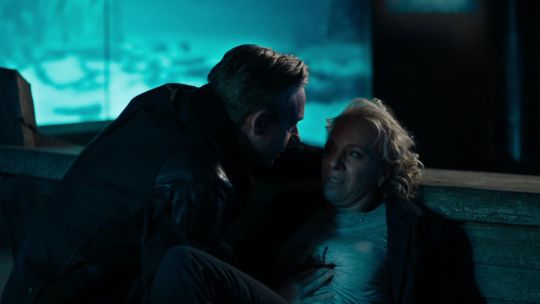
lollol "I'm an army doctor John -5th north Umberland fusiliers- Watson and I'm using my hand to cover the GAPING bullet hole in my wife"✌🏻😎#justarmydoctorthings
#t6t#is this even a meta at this point?#john watson#bbc sherlock#sherlock holmes#sherlock#johnlock#Series 4 fuckery#Mary Watson#rosamund mary#I always liked mary...#well I used to.#So many lies#maris quiry#the six thatchers#vivian norbury#norbury#the eligible bachelor#the London aquarium#cause why not#alibi theory#watsonian
141 notes
·
View notes
Photo
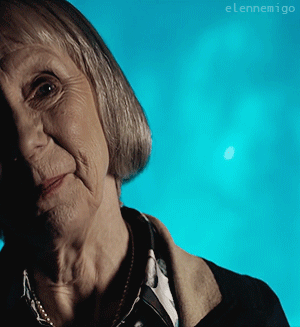
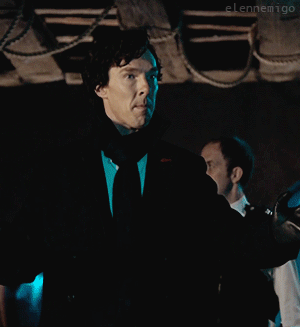
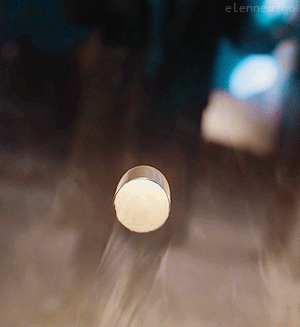

MY GIFTOBER 2019
Day 4: Human Shield + Day 5: Gunpoint (List from @whumptober2019)
Sherlock - The Six Thatchers
#sherlock#bbc sherlock#Benedict Cumberbatch#mygiftober2019#whumptober2019#sherlockedit#no.4#no.5#day 4: human shield#day 5: gunpoint#tw: death#tw: gunshot#tw: blood#mary watson#vivian norbury#i´m so sorry!! :((((#remember mary#elegifs#sh gifs
101 notes
·
View notes
Photo

#offended
#vivian norbury#benedict cumberbatch#Sherlock Holmes#Sherlock#johnlock#Season 4#offended#betrayal#am i a joke to you#meme#funny#mark gatiss#martin freeman#moftiss#la stracciacazzi
115 notes
·
View notes
Photo

I Fight Like A Girl | Sherlock Edition
#Vivian Norbury#women of sherlock#sherlockedit#pink ribbon#I fight like a girl#sherlock pink ribbon#i did a thing
4 notes
·
View notes
Text
New chapter!
I just posted chapter 33 of The Lost Special: Family Matters (As Do Relationships), in case anyone is interested... ;)
#s4fixit #unreliablenarrator #alibitheory
11 notes
·
View notes
Photo
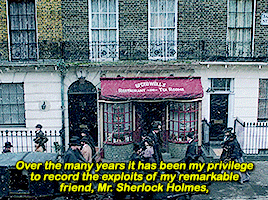
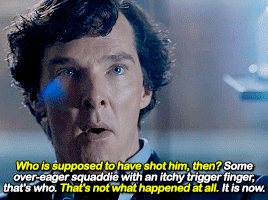
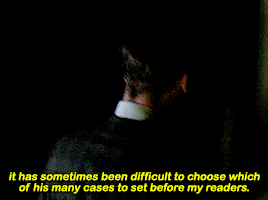


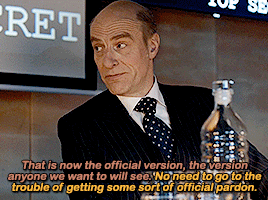
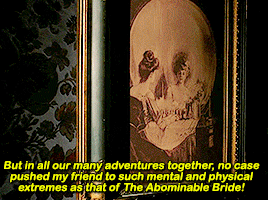
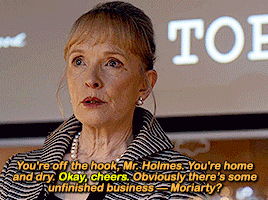
Looking Closer at How The Abominable Bride Foreshadowed and Can Be Used to Chronologically Decode Series 4:
In the opening of TAB, Sherlock imagines John narrating how as Sherlock’s biographer he picks and chooses which of his cases to present to the public, alluding to the nature of John as an unreliable narrator in the canon.
In the opening of TST, John writes Lady Smallwood and co. talking about modifying the footage of Sherlock shooting Magnussen and that their story will become the official one, setting up the nature of John as an unreliable narrator in series 4.
[Continue below the cut for more ➤]
See also: 10 Revealing Things From The Six Thatchers That Haunt You Late At Night, 10 Revealing Things From The Lying Detective That Haunt You Late At Night, and 10 Revealing Things From The Final Problem That Haunt You Late At Night. (#tw suicide)
Bonus: They’re not there:

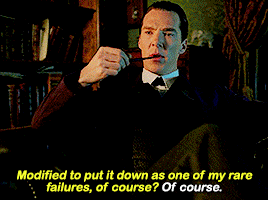

On John’s blog, he wears his heart on his sleeve. He adores Sherlock and clearly loves him even when he tries to downplay their relationship or play up his relationship with Mary. In his post about meeting Sherlock, he calls him “strangely likeable”, and talks like there’s life in for the first time in ages after multiple blog posts about how nothing happens to him.
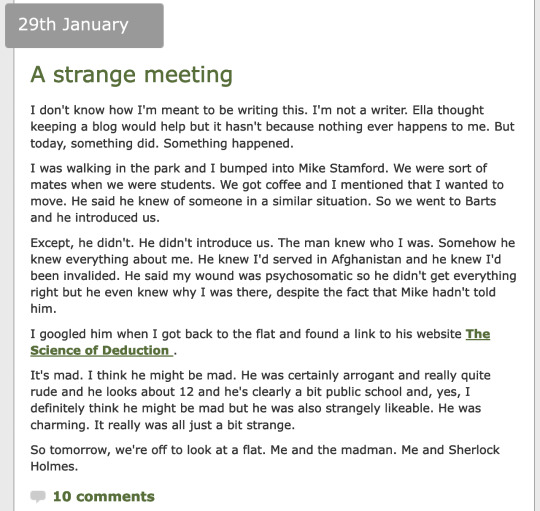
This includes how John thinks that Sherlock not only doesn’t love him back, but that he’s “spectacularly ignorant” about some things, including the way that he feels about Sherlock. How does the world’s only genius consulting detective not notice that? John is pretty forward about this is in one of his early blogs and first one about Sherlock’s cases.
He also says for the first time that he has to omit certain things in order to publish the story at all, echoing the nature of the original stories.
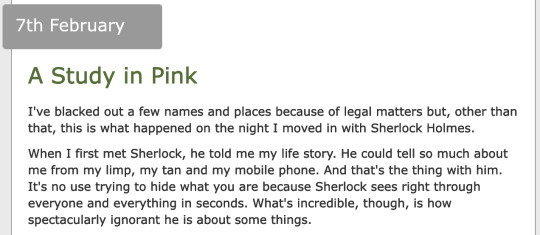
But Watson doesn’t say this in the opening of A Study In Scarlet; he straight-forwardly talks about his return from overseas and his meeting Sherlock Holmes, followed by the case that changes his life. It’s really in the other stories that Watson talks more about altering details, which is what the debate around his authorship revolves around.
It does provide an interesting comparison, though, the way that Sherlock hasn’t yet become the emotionless machine that the myth surrounding Sherlock Holmes is so obsessed with. He laughs, he dances, he expresses emotion alongside his deductions. The last line about Sherlock actually says, “Didn’t I tell you so when we started?” cried Sherlock Holmes with a laugh. “That’s the result of all our Study in Scarlet: to get them a testimonial!”
That changes with The Sign of Four. The opening of the second novel, following the success of the first, is about Holmes and Watson talking about the publication of their first case together.
Holmes: “Yes, indeed,” said I, cordially. “I was never so struck by anything in my life. I even embodied it in a small brochure with the somewhat fantastic title of ‘A Study in Scarlet.’ ”He shook his head sadly. “I glanced over it,” said he.
Holmes: “Honestly, I cannot congratulate you upon it. Detection is, or ought to be, an exact science, and should be treated in the same cold and unemo-
tional manner. You have attempted to tinge it with romanticism, which produces much the same effect as if you worked a love-story or an elopement into the fifth proposition of Euclid.”
Watson: “But the romance was there,” I remonstrated. “I could not tamper with the facts.”
Holmes: “Some facts should be suppressed, or at least a just sense of proportion should be observed in treating them. The only point in the case which deserved mention was the curious analytical reasoning from effects to causes by which I succeeded in unraveling it.”
Watson: I was annoyed at this criticism of a work which had been specially designed to please him. I confess, too, that I was irritated by the egotism which seemed to demand that every line of my pamphlet should be devoted to his own special doings. More than once during the years that I had lived with him in Baker Street I had observed that a small vanity underlay my companion’s quiet and didactic manner. I made no remark, however, but sat nursing my wounded leg. I had a Jezail bullet through it some time before, and, though it did not prevent me from walking, it ached wearily at every change of the weather.
As Sherlock Holmes becomes more of a text, the more Watson mentions about how he to change names, dates, details, or wait until certain people are dead until his stories are published, to protect international secrets and the lives of its characters. But it all started with Holmes and Watson in a flat, talking about how the romance should be suppressed.
In one of John’s early blogs he mentions a fortune cookie at the end, pulling a quote from The Valley of Fear:
“Everything comes in circles—even Professor Moriarty. Jonathan Wild was the hidden force of the London criminals, to whom he sold his brains and his organization on a fifteen per cent. commission. The old wheel turns, and the same spoke comes up. It's all been done before, and will be again. I'll tell you one or two things about Moriarty which may interest you.”

Except John says he think it’s going to be different this time. This version is going to do something different before. It’s going to admit that the romance was there. It’s not going to suppress it anymore by the end. But before it gets there, the story is also about how much, and what therein, the story is being altered in the first place. Enter series 4.
An important blog entry to understanding the mindset of Sherlock and John after series 3 is the last blog entry. To date, the blog is still suspended because if it continued the true nature and mystery of series 4, the answer would be spoiled.
It reads as follows:

Sherlock is openly disinterested and angry at the wedding to anyone who’s paying attention. And not without reason.
The ending of TSOT is one of the most devastating moments in the show. John and Sherlock both realize that neither of them wanted this marriage to happen, that they could have been together and in this passing look they know it’s moments too late after Sherlock realizes Mary is pregnant.
It happens and disappears in a moment.
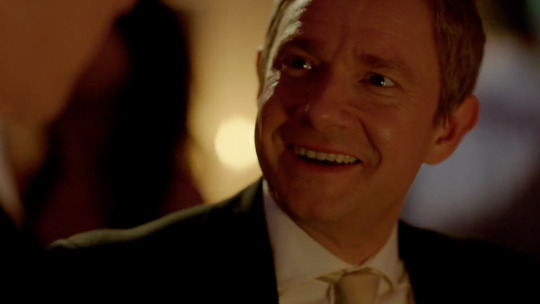
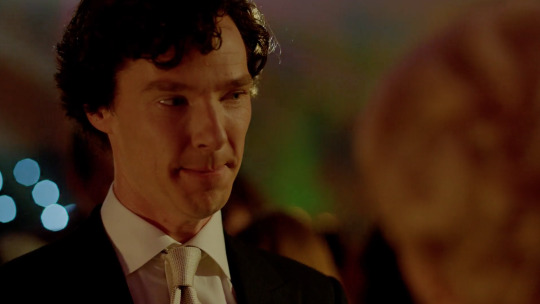
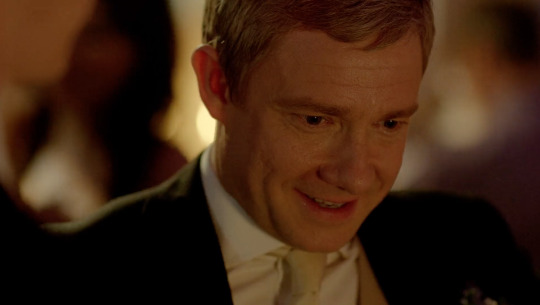
Sherlock leaves the wedding early. A month and one honeymoon later, John will be bursting to get out of his trainwreck of a marriage at every waking moment. He’ll bike to work. He’ll keep his bags packed. When he rejoins Sherlock in the flat he’s practically giddy, and then when he meets Janine and Sherlock explains that he used her later, he’s right back at wondering if Sherlock is capable of loving anyone or not.
And none of this is remotely mentioned in the blog entry. Sherlock takes over for John, foreshadowing that the next act of the show is about to retell The Casebook of Sherlock Holmes, which includes two stories entirely narrated by Holmes. HLV is one of the most devastating episodes of the show and it’s not on the blog at all. The public doesn’t know anything about what happened to them.
The next time we see John’s blog it’s going to say this. Absolutely nothing about their time gone, what Sherlock did or what John is going through. Of course, nothing about Mary either. He isn’t even typing anything like normal; he just fidgets his two fingers on the same two keys, and his blog isn’t on the screen. It’s a screenshot. Because what we’re watching is the blog itself.
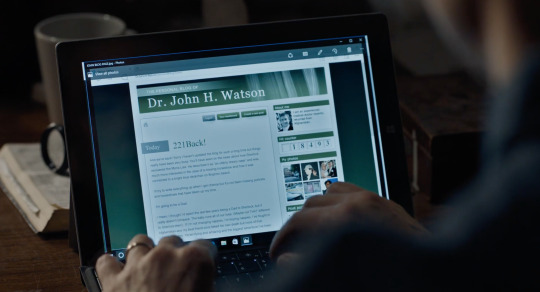
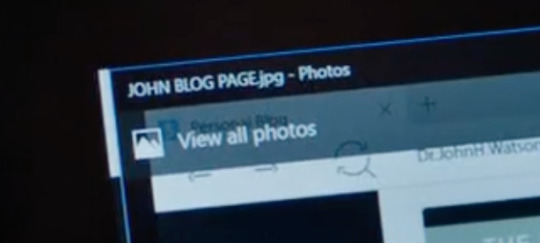
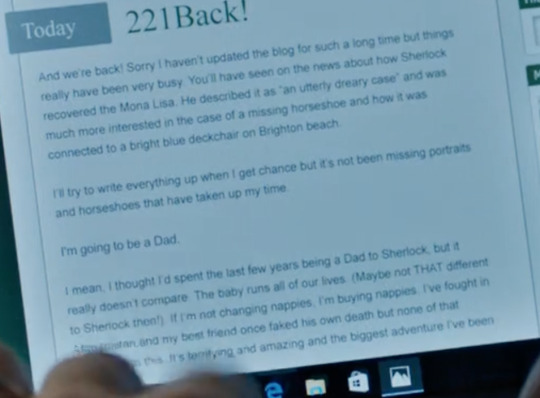
So the parallel starts thus:
After setting up his dream world and arriving at 221B Baker St., and a conversation with Mrs. Hudson about the way that John modifies people to be characters in his story, Sherlock imagines John giving the following narration
Watson: Over the many years it has been my privilege to record the exploits of my remarkable friend, Mr. Sherlock Holmes
The beginning is about putting up the front of John’s purpose and their relationship, calling Holmes his remarkable friend. In the next episode, John as the author takes liberties of his own in order to protect the people in it. He protects himself and Sherlock by covering up the true events of Mary’s death.

In TST, the opening scene is about doctoring the footage of Sherlock shooting Magnussen. With a bright projector light behind Sherlock’s head, the footage cuts out Sherlock putting the trigger as someone walks past the camera. This is being displayed as top-secret information as all of them sit inside a glass window room anyone could sit through.
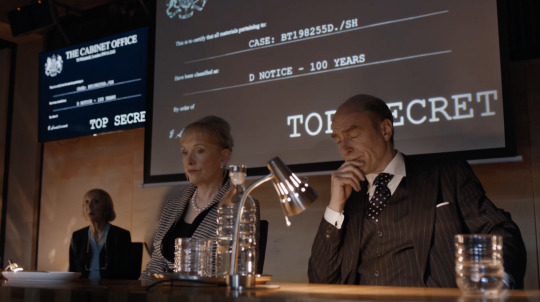
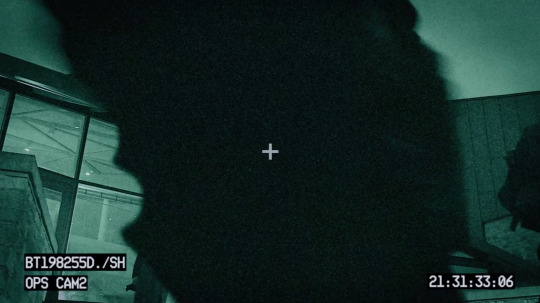
Sherlock and Mycroft describe how it’s different:
I see. Who is supposed to have shot him, then?
Some over-eager squaddie with an itchy trigger finger - that's who.
The over-eager shooter in this story has already conveniently been placed in the room. She has her own pen and paper, but isn’t writing anything down, which is her job as a secretary. It’s because a copy of that text, this conversation should exist, but it doesn’t, because Norbury doesn’t exist. Mycroft tells her not to write it down and put down it down, because once they’re beyond these walls, they must “never speak of it.” There’s also the meaning of Mark Gatiss being a stand in for the show’s writers, similar to the meaning of when John finds the dog’s bones, a correlation to Emelia Ricoletti’s grave being a switch.
It also creates a connection between John the author and Norbury. She’s the one with the pen and she’s going to take the fall, but John is the one who really shot Mary.
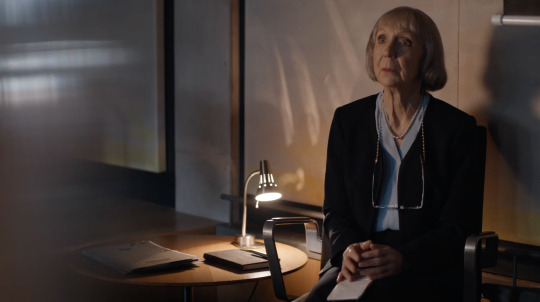
Back in TAB, John continues about how he picks and chooses cases to tell:
Watson: it has sometimes been difficult to choose which of his many cases to set before my readers.
That includes, as far as we know right now, the entirety of HLV. He leaves out Magnussen, Mary shooting Sherlock, Mary’s past, and Sherlock shooting Magnussen at once. It’s not just about the cases though, it’s about other things that John leaves out of his story.
In Sherlock’s mind: it’s not just smaller things that John says, like Sherlock being “spectacularly ignorant” about certain things and wounding his ego or embarrassing him, it’s that John never picks up on how much Sherlock loves him. John is hiding the true nature of their relationship from the world because he doesn’t see all the deductions of how much Sherlock loves him back.
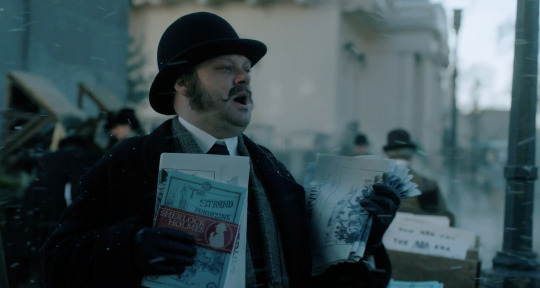

Immediately after the credits in TAB John is praised by for the success of the Adventure of the Blue Carbuncle by a man selling Sherlock Holmes branded content in The Strand Magazine, asking if “there’s going to be a proper murder next time.” He inquires if Sherlock is in the carriage at sight of his profile, the same one printed on the paper he’s carrying, and John dismisses him at Sherlock’s behest. That particular story is from the first short story collection, after A Study In Scarlet and The Sign of Four, and before Sherlock’s presumed death in The Final Problem.
“Remarkable. How did you do it?”
“We have some very talented people working here. If James Moriarty can hack every TV screen in the land, rest assured we have the tech to doctor a bit of security footage.”
John isn’t just talking about how easy it is to doctor footage, but that it’s even easier for him to do as a writer with words. He doesn’t need any government technology to alter the story. All he needs to do is the essence of this scene – lie and invent. Like when John invents the story about Eurus in order to lie about what happened to him where he has a pen and paper.
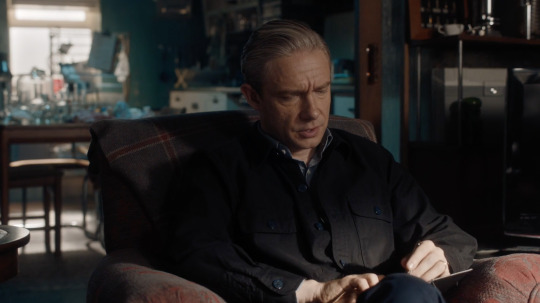
Watson admits the reason he has to do this back in TAB:
“Some are still too sensitive to recount, whilst others are too recent in the minds of the public.”
At the end of the story, Sherlock will ask to make sure that Watson modified the story, to “put it down as one of my rare failures, of course?” The story was progressing like a normal adventure until Sir Eustace’s murder, and then the entire second half of the story was omitted. Sherlock helped Lady Carmichael get away with murdering her husband. He broke his vow, it’s one of his “rare failures”. Sherlock is imagining their marriage in order to try to predict what would happen in the near future and what danger John would be in.
Mary is the case and she becomes the case the next episode. It’s at this point in TAB that we see a shot of the knife in the mantle – connecting to TLD when Mary’s case, the message tied to the dagger, or the case on how to save John, is the one Sherlock still hasn’t solved. The knife is still there in the fake ending of TFP. John thinks he still hasn’t solved it and that’s why he was shot at the end of TLD.
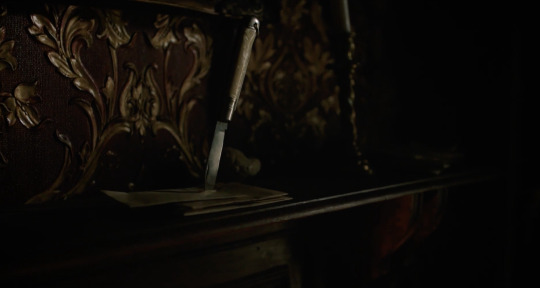
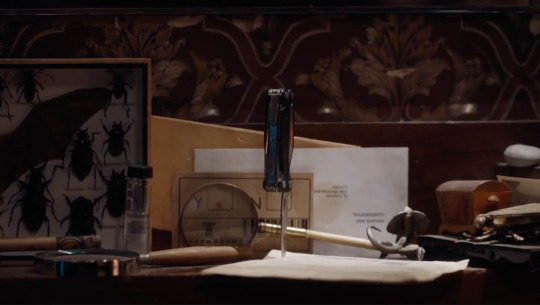

Mary is Sir Eustace with the dark past coming back to haunt her. Mary is the post-humous revenge Sherlock alluded to, the vengeful bride who faked her death to kill her husband, the figure of Death in the Samarra story, and half the ultimate villain – but some cases are still too sensitive to properly recount. Moriarty isn’t back. No, no, no. He’s definitely dead. He planned his revenge on Sherlock five years ago by filming a bunch of reaction gifs and jiving against the glass with Eurus like a snake.
The next episode, Mary’s past comes back to haunt her, and Sherlock breaks his vow. One of his “rare failures”. The over-eager shooter is hauled away as the projector lights the back of her head.


Mary’s death isn’t the only case that John covers up, however. He manages to do that relatively consistently. Even with how on the nose it is, the audience was convinced. The most convincing case is the one that John doesn’t show at all; the cover-up of his own death.
In TST, it’s clear this is about getting away with murder:
That is now the official version, the version anyone we want to will see.
No need to go to the trouble of getting some sort of official pardon.
Lady Carmichael doesn’t have to bother with a pardon and neither does John. His cover-up story, The Final Problem, is an entirely invented entry in the great Sherlock saga, using the name of a real one as a red herring, ending their story and establishing normalcy so no one will know what happened to him next. Series 4 is what happened, officially. But it’s not the truth. John has modified the truth. The romance has been suppressed.


John can’t tell that story because he has to make it convincing enough to draw Mary into the open; he doesn’t want to go to the trouble of getting a pardon when he has to face her again. This has to be the version everyone believes so that when it’s revealed that John committed suicide, everyone believes that too.
John has let his insecurities, self-hatred, and suicidal ideation leak into the subtext of series 4, so that when the news gets out about what really happened, and that the last story in particular was a total fabrication, people believe the secret story hidden beneath the true one. Suddenly the decline of hi stories becomes the tragic tale of a man losing his way and taking his lie. The story ends on a low note. “It’s gone a bit downhill, hasn’t it?” And it is emotionally true, but it’s all part of John’s bigger plan to fake his death.
When Eurus as Faith gives Sherlock the note about Culverton Smith she writes one story on the surface, the one that Sherlock deduces, but hides another message underneath that he doesn’t see until it’s too late. This is the case he didn’t solve.
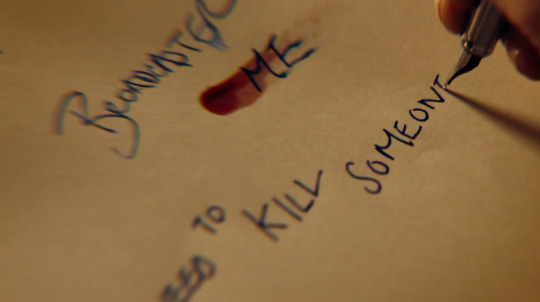

This is what John’s story is: one text subsumed by another bubbling just beneath its surface. When John’s original story falls through because of what happened at the end of TLD, darkness completely overwhelms his story in TFP. Sherlock is drowning in it until he ties a nice bow on the ending. One coverup hiding another coverup. That’s how you sell a big lie; you wrap it in the truth to make it more palatable.
One of John’s blog entries has a picture of the knife stabbed into a clue board. Sherlock figured out that the victim faked his own death.
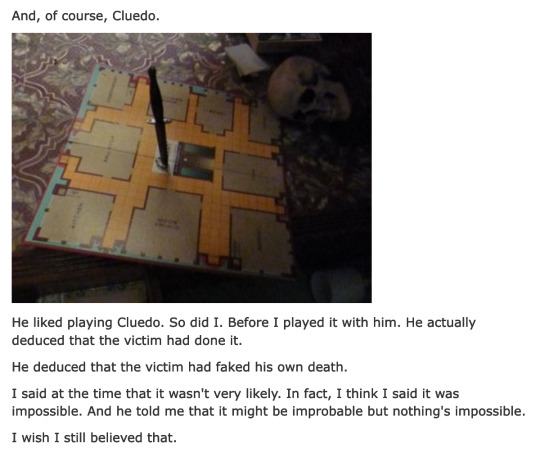
TAB foreshadows the lengths John goes to:
But in all our many adventures together, no case pushed my friend to such mental and physical extremes as that of The Abominable Bride!"
Sherlock is pushed all the way to the predestined end of the story, clinging to life at the Reichenbach Falls with Moriarty punching him down. It’s only when he decides to let John in emotionally that he appears, foiling him easily, kicking over the falls like he isn’t a threat at all. Because he isn’t when they’re together and they openly love each other.
John doesn’t have the same confidence. John thinks that he can’t avoid Samarra – that even if he fakes his death, that happy ending he invents at the ending of TFP is the closest to happiness that he’s ever going to get. Sherlock has more confidence in John and what they can accomplish together. “I’m a storyteller. I know when I’m in one.” The real John knows it too, but he can’t see the same ending Sherlock does if he still doesn’t know Sherlock loves him back. John’s ending is a dark mirror and denial of Sherlock’s hopeful vision.
Nothing has pushed John to such mental and physical extremes as that of the abominable bride. Mary faking her death, returning to manipulate and gaslight him, and trying to get him to commit suicide to burn Sherlock’s heart out of him forever is the worst thing that John’s ever been through. The most trying case in his career working with Sherlock. Faking his death, however, isn’t the end. Because the whole point in all of this is to outsmart Mary and Moriarty, drawing them into the open so John can make his move.
Smallwood: “You're off the hook, Mr Holmes. You're home and dry.”
Sherlock: “OK, cheers.”
Smallwood: “Obviously, there's unfinished business. Moriarty?”
For Sherlock, his unfinished business is Moriarty. For John, it’s Mary. They’re going to have to work together to finally defeat them once and for all – and they can only do that once they both know the truth. Nothing can stop them. Then the spoke will turn, and the world will have something new.
But for now, the truth has to be modified. The romance has to be suppressed. Until the world is convinced John is dead and he’s in the clear.
“That’s not what happened at all.”
“It is now.”
#sherlockedit#tjlcedit#johnlockedit#sherlock bbc#tjlc#john watson#sherlock holmes#mary morstan#vivian norbury#meta#the abominable bride#the six thatchers#edits#gifset#gifs#looking closer at tab timeline#television#john's blog#series 4
90 notes
·
View notes
Photo
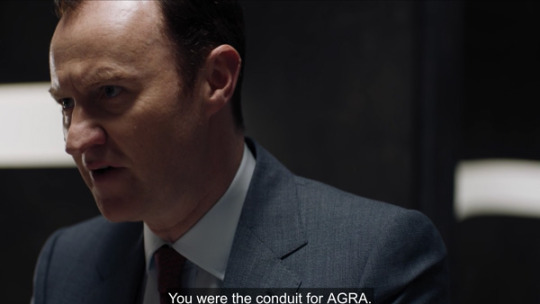

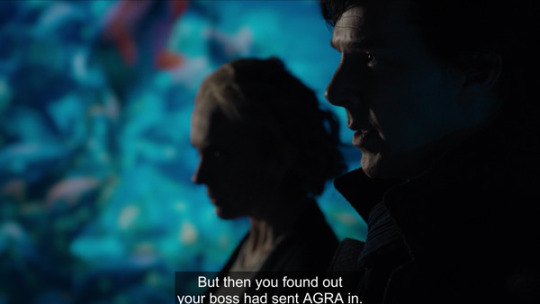


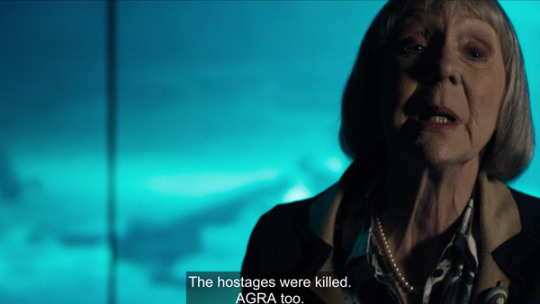

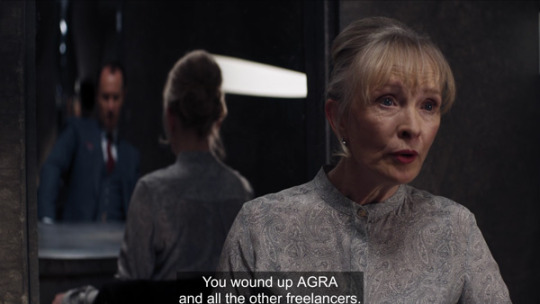
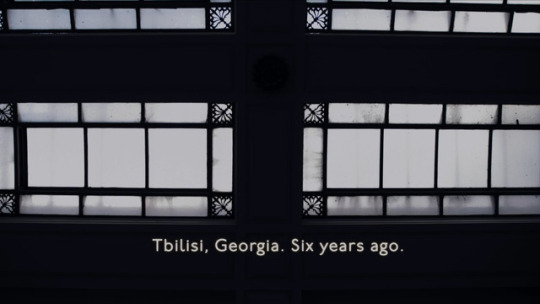

Lady Smallwood gave the mission orders to AGRA.
After Tbilisi, even the secretary who knew too much thought that all the members of AGRA were dead.
YET
Lady Smallwood specifically says Mycroft wound up AGRA along with the other freelancers.
You can’t wind up a team that’s all dead.
The Tbilisi incident was 6 years ago as of The Six Thatchers.
Mary had been in the UK for 5 years as of His Last Vow.
Given the time elapsed between the “five years ago” line and the “six years ago” caption, that suggests Mary came to the UK very soon after Tbilisi.
All of that together makes it really difficult for me to believe Mycroft wasn’t aware of / involved in Rosamund’s post-AGRA reinvention as Mary Morstan.
#sherlock#bbc sherlock#sherlock theories#mycroft holmes#mary morstan#lady smallwood#vivian norbury#sherlock holmes#agra#the six thatchers#his last vow#obviously people have been speculating this the whole time anyway#but i like putting some quotes & numbers behind it#also#something secret enough that lady smallwood knows and vivian doesn't seems like kind of a big deal
224 notes
·
View notes
Text
Follow the dog – Part 6
Part 6: Vivian Norbury – the “What-If” of John’s bisexuality
Previous Parts:
Part 1, Part 2, Part 3, Part 4, Part 5
In the sixth (and penultimate) installment of my ‘Follow the dog’ meta series, we will be talking about Vivian Norbury in s4.
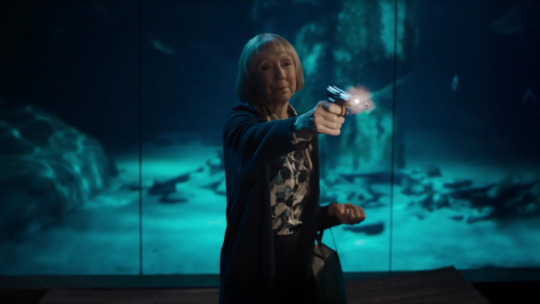
We will address the question of why Norbury has cat hairs on her clothes, what the cottage in Cornwall she owns might represent, and why her characterisation is such an odd mix of John’s, Mary’s and Janine’s traits.
Most importantly, we will attempt to understand what her name (Norbury) means for John and Sherlock.
By analysing Norbury, we will try to answer the following question:
Why did Mofftiss say that s4 was all about consequences? And what can Norbury tell us about these consequences?
(Continued under the cut...)
1. More Cats
But before we get to Norbury, let’s take one step back and remind ourselves what we said in Part 4 of this ‘Follow the dog’ meta series:
I argued that cats represent heterosexuality/heterosexual relationships, what with John being offered heterosexuality a cat in that Chinese shop in TBB and declining the offer.
Also, there’s this here:
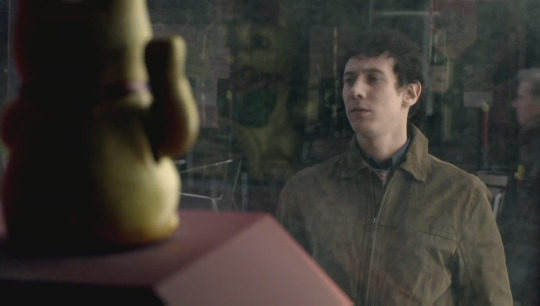
Andy, Soo-Lin’s admirer, who wants to pursue a (heterosexual) relationship with her, is worried about her and searching for her. The mirror image of that ‘cat’ (heterosexuality) is visually sitting on his shoulder.
And, to give you a few more examples, I’m going to write up my replies to several comments I’ve got to Part 4 and Part 5 of this meta. (So sorry again for being so slow at replying to all the reblogs. I’m notoriously bad at replying –usually because I’m drowning in work and/or away on travel for work.)
So, one comment I got was from @raggedyblue, who pointed out that cats as a metaphor for heterosexuality make a lot of sense considering Sherlock’s website ‘The Science of Deduction’. There is a Mr Thompson on this site asking Sherlock for help with his missing cat:
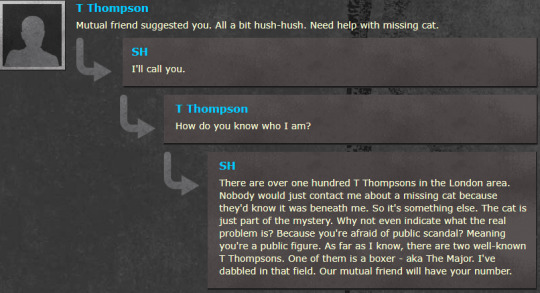
Sherlock brusquely replies that this can’t possibly be about a cat and that there’s surely, ahem, ‘something else’, then Sherlock adds that Mr Thompson is probably scared of a public scandal (!).
Well, this is too good...:) Someone’s ‘cat’ (heterosexual side) went missing? Haha! And now that same Someone is scared of exposure and a scandal? And Sherlock even points out that this is not about a cat (metaphorically, this is indeed, about ‘something else’ than an actual, real-life cat). :D
And need I tell you that ThompSON could be a nice mirror for WatSON? (Let’s not even go into the whole fact that this could be Ella Thompson’s husband, which would make Ella a Sherlock!mirror of the first order. I mean, Ella has been a slightly distorted Sherlock!mirror right from the start, what with telling John, in TRF, he should articulate his feelings for Sherlock after Sherlock jumped...just to give you one example.)
Mr Thompson, who has lost his cat, is even a Major. He’s military, like John!
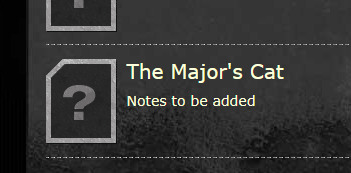
So, yeah...his ‘cat’ went missing! And once you read their whole exchange with my proposed translation of ‘cat’=heterosexuality in mind, it becomes so funny. Sherlock even says, “Why not indicate what the real problem is?”
Why, indeed...:D
And the wording: the whole thing is referred to as “hush-hush”. *rofl* Yeah, I bet it is, Mofftiss. I bet it is.
So, thank you, @raggedyblue for pointing this little gem out to me. I just had a lot of fun reading that one with my metaphor-goggles on.:)
By the way, some time later, we get this cryptic post by Sherlock:

And now, the ‘cat’ (heterosexuality) is associated with a fake screen (!). This keeps getting better and better.:)
In Part 4 I had already pointed out that Molly (whenever she’s not acting as a John!mirror, but as herself) has taken a (heterosexual) interest in Sherlock. And this is Molly’s blog:

Cats...cats...cats...everywhere.
Remember what I said about Sarah telling John he could maybe sleep at the end of her bed (like a ‘dog’)?
Because this is one of Molly’s posts about her ‘cat’ Toby. The ‘cat’ sleeps on her bed! The post then veers seamlessly into pining for describing Sherlock and his flirting.
“At least Toby will never leave me.” Yeeeeah, as I said... Cats=heterosexuality. QED.

The comments underneath Molly’s blog post confirm it: They’re a conversation between Molly and Moriarty, who wants to take Molly out for ‘coffee’ even though we all know that Jim’s more into some madly stirred ‘tea’. So ‘coffee’ turns up right underneath this ‘cat’ post! As I’ve been arguing before, ‘coffee’ and ‘cat’ refer to the same concept: heterosexuality.
Also, note that Molly’s ‘cat’ is called Toby(!).

In s4, Sherlock will directly compare John to ‘Toby’ who, in Sherlock’s case, is a ‘dog’ (obviously!). And that’s not even in the subtext. That’s right there in the text.:)
And, yes, ladies! A ‘cat’ (heterosexual relationship) is far less fuss than having a gay best friend. You’ve been warned.:P
Let me add one last piece of evidence that the whole cat=heterosexuality metaphor is real and a long-term metaphor-game Mofftiss have established.
And yet again, this discovery is not my own: @possiblyimbiassed pointed it out to me in a comment to one of the previous parts of this meta series:
When Sherlock’s returns from the dead in TEH, John scolds him for never having contacted him. Sherlock replies that he almost tried to contact him a few times, but that he was scared John wouldn’t be able to keep it secret.
Now, what’s interesting is the wording here, which is what @possiblyimbiassed pointed out to me. Sherlock says:
“I’ve nearly been in contact so many times, but … I worried that, you know, you might say something indiscreet”.
"What?”
"Well, you know, let the cat out of the bag.”
On the surface level, Sherlock is just telling John that John wouldn’t have been able to keep his mouth shut about Sherlock being alive. On a metaphorical level, however, Sherlock is saying that Sherlock ‘telling John’ could have possibly forced John to confront his (indiscreet=gay) feelings for him and (in an act of gay!panic) led to John turning to heterosexuality (the ‘cat’) instead, ie, John would have ‘let the cat out of the bag’ as in: turned to women to quell his gay!panic attack.
Thank you, @possiblyimbiassed for pointing this out. I think this little exchange in TEH has much more depth once we read it this way.
By the way, it’s interesting to note that what happened was actually the reverse: Sherlock NOT telling John led to John finding another woman (Mary). So, Sherlock actually miscalculated rather badly on that account.
2. Vivian Norbury as John’s dystopian choice
Now...having said all of that...
What about the cat hairs on Norbury’s clothes? Just an indication that she’s straight? Why do we even need to know what her sexual orientation is? If we were to take s4 at face value, she’d be a secondary character at best. Why bother to tell us her sexual orientation? Well, obviously, we’re not supposed to take s4 at face value, then. And obviously this is not about HER sexual orientation.
So...
Norbury.
Vivian Norbury.
We’ve all already noticed that she’s a weird mix of John and Mary (with some Janine thrown in for good measure), and there are about a dozen different theories as to why that may be the case.
This is the theory that I would like to bring to the table:
It is based entirely on the assumptions I have made in earlier parts of this ‘Follow the dog’ meta series (assumption 1: dog/dog hairs=homosexuality, assumption 2: cat/cat hairs=heterosexuality).
So, basically, my theory is this:
Vivian Norbury is the heterosexual side of John’s bisexuality, but not the real one! She’s the horrible, dystopian vision of a heterosexual side that has won, that has gained the upper hand in a parallel (unreal) universe. She is a monstrous personification of what John’s life would be like if he were to actually choose his heterosexual side and get stuck in that life for decades to come.
(I know there is more to Vivian Norbury than that. The mirroring is really complicated with her. She’s not just coded, she’s double and triple coded. But in this meta, I would like to look at one layer of coding in particular.)
I will try to explain why s4 is, in Mofftiss own words, all about consequences!
So let’s talk about evidence. How do we know that Norbury is literally John’s heterosexual side (the AU!consequence of his heterosexual choice)?
Because...Cat hairs!
Sherlock tells us Norbury has cat hairs on her clothes.
Remember Sherlock’s ‘body’, his ‘transport’, in Part 3 of this meta series? Sherlock’s ‘body’ was 300% gay because of the dog hairs.;)
Also, remember Connie Princes’s ‘cat’ in TGG, which I wrote about in Part 5 of this meta. The cat was naked, ie, didn’t have any fur (‘cat hairs’). Which is an interesting twist on this theme: I had analysed Connie and Kenny Prince as John’s heterosexual and homosexual sides respectively.
But the ‘cat’ (heterosexuality) Connie owned didn’t have any fur, ie, no ‘cat hairs’ left. So, basically John’s heterosexual relationships were already pretty dysfunctional at that point.
But that’s a detail about the Connie/Kenny=bisexuality metaphor that’s neither here nor there.
The cat hairs on Norbury mean that we’re looking at the side of John’s bisexuality that is straight, the side of John’s that experiences attraction towards women.
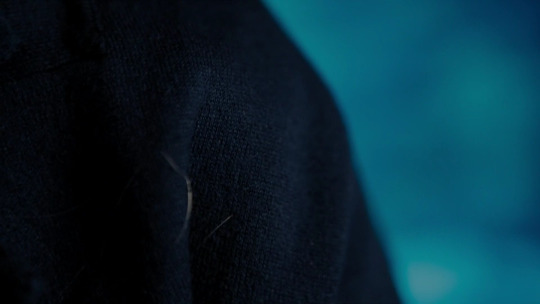
But first of all: How do we even know we’re talking about John here? Why is Norbury specifically HIS heterosexual side, not somebody else’s or maybe heterosexuality in the general population or heterosexuality as a general concept?
Because there’s also this:
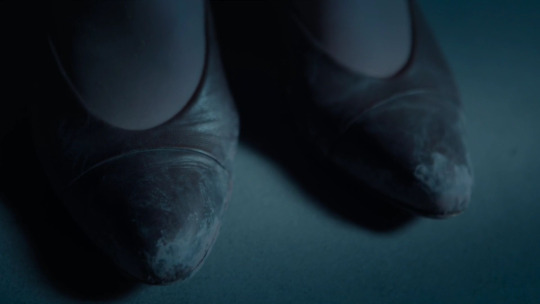
Sherlock deduces that Norbury lives in Wigmore Street by looking at the distinctive clay on her shoes because the pavement in Wigmore Street has been taken up in front of the post office.
This is lifted straight from ACD’s ‘The Sign of Four’. Only there, Holmes makes that deduction about Watson!
This is all about John.
And don’t forget that ‘The Sign of Four’ (SIGN) is the story where Watson meets Mary and gets married. It is specifically that one ACD!canon story that deals with Watson’s heterosexual side!
So, that quote being attached to Vivian Norbury means that she is about two things: 1) John and 2) his heterosexual side. Gatiss did not just pick any quote from ACD!canon, he picked one from SIGN, the story of John’s heterosexual relationship with Mary!
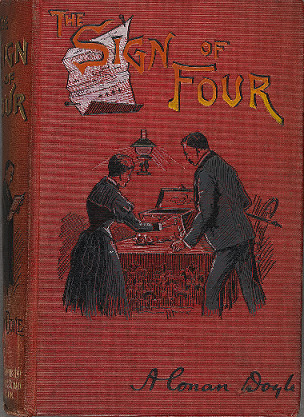
(x)
The deduction Holmes makes about Watson and Wigmore Street happens at the beginning of SIGN, right on the first page of the first chapter. Holmes deduces that Watson has been to the post office there and sent a telegram because of the dirt of Watson’s shoes.
Watson is surprised that Holmes knows this since he only sent that telegram on a whim and hadn’t told Holmes prior to it. (I think we actually never find out who that telegram was intended for. I hope I remember that correctly.)
From that telegram deduction, Watson and Holmes launch into a long conversation, in which Holmes deduces one thing after the other, it’s a chain of deductions, a long talk which culminates (at the very end of the chapter) with Mary literally ringing their door bell. So, what starts with that deduction about Wigmore Street and the post office ends with Mary turning up in their lives and interrupting them. Literally.
What begins with Wigmore Street ends with Mary appearing and taking John away. This is what Wigmore Street stands for.
Now, here, in TST, we have a character (Vivian Norbury) who LIVES in Wigmore Street. She literally inhabits Wigmore Street! This is a personification of that mistake that Watson makes in the ACD!canon, a mistake that begins with the conversation about the post office in Wigmore Street and ends with Mary’s appearance in their lives.
Obviously I have no idea what ACD meant (or if he meant anything at all) when he was writing that first chapter of SIGN.
But the fact that the first chapter of SIGN literally starts with Holmes taking drugs and ends with Mary Morstan knocking on their door seems to suggest that ACD did, in fact, know what he was doing when it came to structural choices and metaphorical meaning.
The cocaine at the beginning of the chapter and Mary Morstan at the end of the chapter are juxtaposed in a way that suggests that: When John chooses one, Holmes will choose the other!
This is also evident from that infamous quote at the end of the whole story where Holmes tells a Watson who has just talked of his intention to marry Mary that for him ‘there remains the cocaine bottle’. Watson’s impending marriage to Mary and Holmes’s drug use are linked here. (Which is also incidentally why I think that @possiblyimbiassed‘s idea that EMP might start immediately after the wedding and that Sherlock has tried to kill himself after the wedding by overdosing on drugs is such a brilliant theory.)
So, The way ACD has decided to write this makes it very, very clear that this is a true statement:
If Watson chooses his heterosexual side, then Holmes takes drugs.
This is also confirmed in TPLoSH, Mofftiss’ favourite film.
Also, @gosherlocked pointed out something really ingenious to me too:
We all cheered when the tea code was confirmed in TLD, but what we all neglected, according to @gosherlocked, is the context of that TLD scene:
Sherlock and Billy Wiggins talk about ‘a cup of tea’, but that cup of tea is filled with equipment for the cooking of drugs! Think about that for a moment. If tea is ‘gay love’, then we should really, really be worried about the fact that that tea cup is NOT actually filled with ‘tea’, but with drugs. Thank you @gosherlocked for pointing this out because I think this is so, so important.
The drugs have literally taken the place of ‘gay love’ in TLD. The drugs have replaced gay love. That’s why we shouldn’t just be celebrating the confirmation of the tea code in TLD, we should be really, really worried about Sherlock.
Anyway... We got a confirmation that Sherlock's drug abuse is directly linked to John choosing to be with a woman instead of with him.
If John Watson chooses his heterosexual side, Holmes chooses the cocaine bottle. The two things are directly, causally linked.
BTW...
That first chapter of SIGN is such a treat!
Immediately after the Wigmore Street deduction, we get the infamous watch deduction, in which Holmes examines Watson’s watch and tells him his brother was a drunkard, who came from a well-to-do home but periodically fell into poverty, and there’s this subtle mirroring going on between Watson’s drunkard of a brother and Watson himself.
And then the next chapter gives us that interesting ‘triple poisoner’ quote in which Holmes warns Watson not to trust a pretty face, which (as @tjlcisthenewsexy recently pointed out in their meta here) was used in TLD. In a veiled way, Holmes likens himself to the man who’s ugly on the outside, but has great hidden qualities on the inside and compares Mary Morstan (who has only just turned up in their life) to the triple poisoner who had a pretty face. Really, SIGN is a fantastic treasure trove for understanding s4!
Anyway...So, the mention of Wigmore Street in SIGN leads directly to Mary Morstan appearing. Wigmore Street leads to John’s heterosexual side turning up.
So, I think we’re not amiss to assume that this mention of Wigmore Street in TST was included to point us in the direction of John’s heterosexual side, too: Norbury inhabits whatever Wigmore Street stands for! Norbury lives on Wigmore Street, after all.
If we, now, assume that all of s4 (at the very least) is happening inside Sherlock’s head, then this scene in TST, in which Norbury appears at the aquarium, is actually Sherlock looking at John, at one particular aspect of John’s sexuality (his heterosexual side) to be precise. This is Sherlock trying to come up with a scenario of “What would happen if John chose his heterosexual side?” Sherlock is running some sort of thought experiment in which he lets John pick his heterosexual side and it all turns into this clusterfuck of epic proportions: This is a dystopian alternative!universe, in which everything turns to shit. (But it’s not real, obviously.)
Let’s look at (Norbury) John’s heterosexual side some more: She looks a lot like the mother from the unemployed-fisherman-and-his-mother deduction scene in THoB (cf. Part 2 of this meta). Even the hairstyle and age are similar.
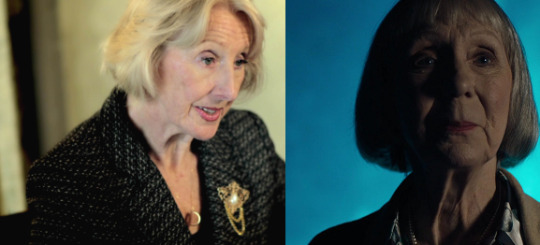
This is John’s heterosexual side that has gotten really, and I mean, really old. A heterosexual side that has got rid of the homosexual side (the ‘fisherman’) altogether. A heterosexual side that is vindictive and manipulative and thinks it’s cleverer than anybody else, but hates, hates, hates the fact that it has been relegated to the rank of a secretary and is constantly forced to play second fiddle. (John isn’t really that emotionally invested in his heterosexual side, as we see throughout the show. So ‘she’ is now really vindictive and on the warpath.)
At the beginning of TST, Norbury is easy to overlook, and people do overlook her all the time. So, what if that heterosexual life suddenly ran amok and became vindictive?
The fisherman’s mother still had traces of homosexuality (dog hairs) all over her in THoB.
Vivian Norbury, on the other hand, has the hairs of three (!) cats on her clothes and nothing else. No dog hair in sight.
This is a metaphor of what John’s life would look like if he had chosen to stick 100%, no 200%, no 300% (!) to his heterosexual side. If he wouldn’t pursue anything with a man EVER again, not even a kiss, if he would exclusively date women from now on. That is Norbury! A monstrous personification of John’s (wrong) choice.
We had already discussed the fact that, over the course of the show, John will have to choose between two options when it comes to his love life, and that those two options are embodied in those salt-and-pepper shakers that are so reminiscent of the wrong-choice-or-right-choice bottles of the cabbie in ASiP (for the two choices cf. Part 4 of this meta).

Vivian Norbury in TST shows us what the wrong choice would look like. She is the personification of it.
What’s particularly disturbing is that Norbury has gotten rid of the ‘unemployed fisherman’ (John’s homosexual aspect) altogether. She is there all alone. Like the ‘sentimental mother’ in THoB she is still attached to her wedding ring. Out of sentimentality. But there’s nothing going on in her love life anymore. Love is dead! Has been for years. That is John’s love life, that is John’s sex life, in this alternative horror!verse that is s4.
Sherlock is working out (in his EMP) what John’s life would be like if he chose to live a heterosexual life, permanently: All love in John’s life would have died years ago. He would start drinking in earnest again. (Remember Vivian Norbury’s drinking Sherlock mentions in this scene.)

And John’s hand would start shaking again.
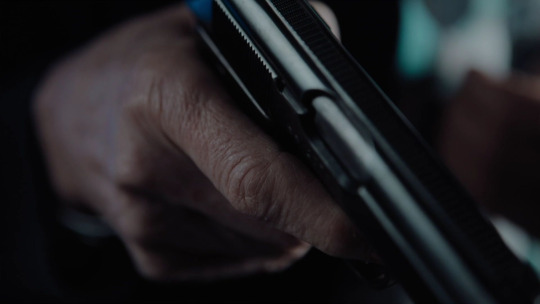
By the way, since @ebaeschnbliah asked me what I make of John’s shaking hand, here’s what I think it means:
Remember that John’s wounds in ASiP all have a metaphorical meaning (cf. Part 4 of this meta series):
Wound in the left (!) shoulder=broken heart (aka a gay relationship in the military that went south)
His limp dick that only Sherlock can cure :P and that is totally psychosomatic and not physical at all=trouble ‘performing’ in bed
So, it’s only reasonable to assume that the third thing that’s wrong with John in ASiP (his shaking hand) is a metaphor, too: The left hand is where the wedding ring goes. Mycroft tells John that his left hand is shaking, but not when he’s experiencing the ‘war’ element in his life with Sherlock (’war’=same-sex attraction). John’s ‘wedding-ring hand’ is steady when it’s all about Sherlock. But it starts shaking when the ‘war’ is taken away from him.

So, you can probably guess what that shaking hand of Norbury means (Sherlock has been taken away from John; John’s ‘wedding-ring hand’ is shaking, the ring was moved to Norbury’s other hand and is connected to a ‘dead’ love life now, and most disturbingly: Norbury’s left hand now packs a gun, a gun that we know John used to look at in his suicidal moments in ASiP). I.e., John exchanged one for the other: the steadiness of the ‘wedding-ring hand’ for the ‘shakiness’ of a 'suicide hand’. He literally made his ‘wedding-ring hand’ shaky and suicidal.
Norbury’s shaking hand means that Sherlock (in his EMP) has worked out that a 300% heterosexual life for John would mean that John would become suicidal and lonely again. When the left hand is missing that invisible ring Sherlock has put on it, it’s shaking and not steady.
All of that seems pretty clear-cut:
Norbury=a vision of John’s heterosexual side in an AU!, in which it (his heterosexual side) got rid of the homosexual side altogether. She is the big “What if” of John’s sexual choice (just like s4 in general is a bit of a dark, dystopian “What if”-version of the show at times).
Now, what about the fish?
After I had written Part 2 of this meta series (the unemployed fisherman and his mother), in which I speculated that the fisherman used to ‘fish’ (aka ‘hook up’ with men) in the past, but doesn’t anymore, @gosherlocked posted this interesting idea about fish representing gay hook-ups in general. @gosherlocked pointed out the aquarium scene with Norbury as an example that still needs to be addressed and interpreted. So, I shall try that.
(BTW, since then, @devoursjohnlock has corrected my assumption that the metaphor ‘fishing’ represents gay hook-ups specifically, by explaining that ‘fishing’ probably means ‘hook-ups’ in general. It just becomes gay by association with the fisherman (John’s homosexual side) and the tour guide (THoB) who went ‘fishing’ with his MOD (!) buddy. And I agree with @devoursjohnlock on this. ‘Fishing’ is probably just a general reference to ‘hooking up’ with someone of either gender. It only becomes a gay reference once you put it in the right context.)
Anyway, look at that aquarium scene in TST again: Norbury (John’s heterosexual side) has got rid of the fisherman altogether. Now she is literally looking at ‘fish’ through glass. She even says she comes here to watch (!) the fish. She is not allowed to touch the ‘fish’ anymore. She can’t. She is looking at ‘all the fish that are out there in the sea’ through a glass pane.
That’s a really, really sad metaphor, guys.
In Sherlock’s EMP that is presenting us this horror!verse here, John has chosen to live a heterosexual life exclusively. And he can now only stare at the bodies that he desires (through a glass pane!). He can’t touch them. (Here, too, it becomes gay by association...because we know WHICH bodies John would not be allowed to touch anymore if he chose heterosexuality: male ones.)
That is sad as fuck.

The general sadness of that scene, this feeling that you get that Norbury has let her life pass her by without taking the chances it could have offered her, the way she talks about never actually being a field agent and just looking at the ‘fish’ now...all of that is pretty heartbreaking when you run it through our metaphorical translator and read this as John in an AU! in which he chose to lead an exclusively heterosexual life.
Imagine a John who (in this alternative!universe) grows old, and 30 years later lives an exclusively heterosexual life, a John who sometimes likes to sit on a park bench and stare longingly at handsome men from afar, men that he can’t be with. He drinks. His hand is ‘not steady’. He has only ‘sentimental’ memories left of what true love was like.
This is awful. This is torture.
And since Baker Street is always compared to the heart of the whole love story, consider this: Norbury lives in a small flat. Yes, a small flat.
John’s love life is small, tiny, cramped, nothing he feels at home in.
That, in my opinion, is the function of Vivian Norbury in TST. She shows us an alternative!universe version of what John’s life would be like if he made the wrong choice.
And since this is probably all in Sherlock’s EMP, that’s actually what Sherlock imagines John’s life would be like if John made that wrong choice. This is what Sherlock is in the process of working out in TST.
BTW, that heterosexual choice that John made in s3 was called Mary Morstan (if s3 is even real). That makes it obvious why Norbury has to mirror Mary, too. After all, Mary is how John’s heterosexual side manifests. She is that wrong choice that John has made.
If you look at how awful (drinking, shaking hand, etc.) that wrong choice makes John feel, you will probably understand why this monstrous personification of his heterosexual choice is explicitly named Norbury, too.
‘Norbury’ is a reference to ACD!canon (YELL). ‘Norbury’ is a catchphrase to be used by Watson on Holmes whenever Holmes errs and goes wrong on a case. ‘Norbury’ is basically what Holmes’s big mistakes are to be called from then on.
And Mofftiss have literally named John’s heterosexual choice Norbury: the biggest mistake there is in BBC 'Sherlock’!
But let’s not forget that this is probably all in Sherlock’s head (I’m willing to bet money on the fact that once s5 comes out, it will turn out that s4 was in Sherlock’s head somehow). If it’s all in Sherlock’s head, that means that this is not so much John calling his heterosexual side a ‘Norbury’ (a big mistake), this is Sherlock calling his own choices regarding John a ‘Norbury’!
Sherlock decided to let John go (in TSoT), he decided to let John live his heterosexual life with Mary. So the wrong choice that we’re actually looking at here is Sherlock’s. By naming John’s heterosexual side ‘Norbury’, Sherlock (in his EMP) is telling himself: I should have fought for him harder. I shouldn’t have let him go. Not just for my own sake, but because once John has made that wrong choice, he will end up an unhappy alcoholic with shaking hands 30 years down the line.
So, the mistake that has been made is not only John’s heterosexual choice. The mistake, Sherlock seems to be telling himself here, lies with Sherlock too. He should have fought for John. He shouldn’t have let him go. That’s Sherlock’s ‘Norbury’. And that’s why Norbury, John’s heterosexual side, is called ‘Norbury’ (a big mistake) in Sherlock’s EMP.
Like in the ACD!canon where the concept of ‘Norbury’ is linked to Holmes ‘getting a little overconfident in [his] powers, or giving less pains to a case than it deserves’ (YELL), this ‘Norbury’ in TST is Sherlock realising that he hadn’t paid enough attention to the case (the case=John Watson!) prior to John’s wedding, that he had been too overconfident in his own deductive powers and had been far too certain that John loved Mary and would be happy with her.
This ‘Norbury’ tells us that Sherlock (in his EMP) has worked out that he was wrong about John, that John wasn’t happy with Mary, and that 30 years down the line John would be an absolute wreck if he were to choose heterosexuality permanently.
That, in my opinion, why Norbury is called ‘Norbury’ in TST. It’s Sherlock realising what a colossal mistake he has made, how massively he has misjudged the situation and what that will mean not only for his own, but also for John’s future.
Using the name Norbury, Mofftiss have connected the ACD!story of ‘SIGN’ where John chooses Mary and marries her with the concept of the colossal misjudgement (Norbury) from a different ACD!story.
Now, one last thing.
About Norbury’s cottage.
In TST, Sherlock says Norbury procured a cottage in Cornwall.
For this, we have to remember who recently told us she bought a cottage, too:

Janine.
Hers is not in Cornwall, hers is in Sussex.
Now, here’s where I think we’ve gone wrong as a fandom:
As a fandom, we sometimes (understandably) let ourselves be ruled by wishful thinking.:) We love the idea of retirement!lock, of Sherlock and John living together in a cottage in Sussex, spoonfeeding each other honey like the love birds that they are, watching the bees *cough* pollinate the flowers.:P
We love our headcanons of the Sussex cottage because we take it from ACD’s later stories and enhance it by adding John to the equation.
But what if Mofftiss AREN’T doing that? What if they don’t see Sherlock’s retirement through our pink rose-tinted glasses? (At least not yet...)
What if, to Mofftiss, the cottage in Sussex is (at least for now) a negative symbol, not a positive one? The cottage in Sussex is where Sherlock will move to when he grows old, all alone. The Sussex cottage is where he will die alone. It speaks of misery, loneliness and lost chances that were never taken, opportunities that weren’t explored.
Obviously that’s not gonna happen. Don’t worry.
But in an alternative!universe (EMP, aka, Sherlock’s head), this is in fact happening. In that alternative!universe, Sherlock will grow old all alone and the point where this horror!verse departs from our story is somewhere around the time when Sherlock’s ‘relationship’ with Janine happens. (It doesn’t matter if those scenes with Janine are real or if HLV is already entirely EMP. What’s important is that Janine is the first representation of that ‘wrongness’, of that AU!outcome.)
Janine is a fake girlfriend, fake!amo (like Vivian Norbury). If Sherlock Holmes (the character that has existed for 120 years) chooses fake!straightness (aka Janine) to hide behind, then this will end in the bleakness and loneliness of an empty cottage in Sussex where he will die alone. That’s why the Sussex cottage is connected to his fake!amo (Janine). It’s connected to the screen of his fake!straightness that has prevailed in adaptation after adaptation for the last century. If the Sherlock Holmes character chooses to go down the path all other adaptations have drawn so far, it means he will live in that cottage alone.
Janine even tells us she’s getting rid of all the beehives! Remember what I said about sweetness in your tea or coffee symbolising happiness (in Part 4 of this meta series)? Sherlock will retire alone and won’t have any ‘honey’ (no sweetness) in his ‘tea’ once he lives abandoned, old, and lonely in that cottage in Sussex because symbolically, there won’t be any beehives left.
Sherlock Holmes choosing fake!straightness (like he has for over 120 years now) inevitably leads to that outcome for his character. (Obviously this will not be the case in this adaptation.) But so far, this is where the mistake lies: fake!straightness, fake!amo.
Norbury owns a cottage in Cornwall.
You all know that this is all about the ACD!story ‘The Adventure of the Devil’s Foot’ (DEVI), which they’re also playing with in TLD, but I won’t go into this here.
In DEVI, Watson takes Holmes away to a cottage in Cornwall because Holmes is not well at all: He’s haggard, completely worn-out and too dependent on his nasty drug habit. The drugs are eating him up. (There are many, many more features of interest in DEVI, but I’m trying to keep it brief here. So, that’s a discussion for another time.)
What I’m trying to say is: If John chooses his fake!amo, his heterosexual side (as personified by Vivian Norbury and her ‘possession’ of the Cornwall cottage), then they will metaphorically end up in that Cornwall cottage, ie, Sherlock will take drugs, be unhappy and work himself half to death.
Both fake!amos are connected to cottages, and we’re basically given a “What if” glimpse of an alternative!universe, an idea of how those (wrong) choices will work out for both Sherlock and John:
Sherlock choosing Fake!Amo Janine (=hiding behind fake!straightness) leads right to a lonely, sad retirement in a cottage in Sussex.
John choosing Fake!Amo (his heterosexual side as personified by Norbury) leads right to Sherlock becoming drug-dependent, worn out, tired and sick in a cottage in Cornwall.
The two are two sides of the same coin. The two cottages represent the consequences of those wrong choices by Sherlock and John.
Choices that our protagonists won’t make (obviously), but available options, so to speak. Options that have been played out again and again for more than 120 years in adaptation after adaptation.
And that...THAT is why, in those interviews before s4 even aired, Mofftiss kept telling us that s4 would be all about consequences.
S4 is showing us the consequences of those wrong choices.
I know there is more to Norbury than just this one layer. But it won’t all fit into this meta, which has gotten too long to be real, anyway.
Let me just quickly ask the following questions:
When we look at Norbury shooting Mary, is that John’s heterosexual side shooting a Sherlock!mirror (Mary’s curls!)? Is that John’s heterosexual side breaking Sherlock’s heart and destroying him?
Does that mean that John choosing his heterosexual side, shatters, destroys, ‘shoots’ Sherlock?
Is that why the scene in the London Aquarium in TST mirrors the shooting in Magnussen’s office?
Is Mary shooting Sherlock in HLV even real? Or is Sherlock just dressing up the same story with different faces? Is it maybe always about John’s heterosexual side killing Sherlock somehow?
Or is Mary (at least in that one scene in TST) really literally Mary, not a Sherlock!mirror for once?
Because if Norbury is an aspect of John, then that means that John was originally supposed to metaphorically ‘kill’ Sherlock (they were supposed to fall in love).
So, ‘John’ was aiming at Sherlock. But because Norbury is John’s heterosexual side, Mary jumped in. She got metaphorically ‘killed’ instead of Sherlock. She literally took his place.
I don’t know...But it’s something to think about.
And, as I said, one of the things that we should always keep in mind is that it’s perfectly possible that Norbury is double coded. Maybe even triple coded. God only knows if she’s more than just a mix of John, Mary and Janine. Maybe she’s also foreshadowing a reveal about Sherlock’s past. But we don’t have any data yet. So, let’s not speculate for now.
The next (and last) part of this meta series can be found here: Part 7.
All screencaps taken from here. I have now updated and sorted through my ‘Sherlock’ meta masterpost, so you can find all my Sherlock meta: Here.
Tagging a few people who might be interested in this: @ebaeschnbliah @gosherlocked @88thparallel @fellshish @raggedyblue @sarahthecoat @tjlcisthenewsexy @the-7-percent-solution @mrskolesouniverse @monikakrasnorada @possiblyimbiassed @spenglernot @221bloodnun
84 notes
·
View notes
Photo
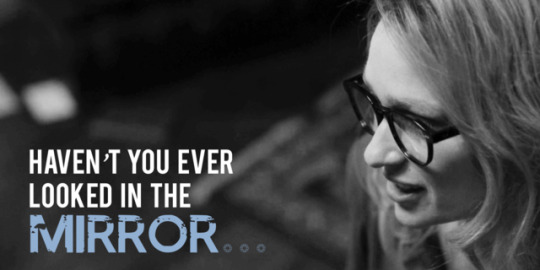
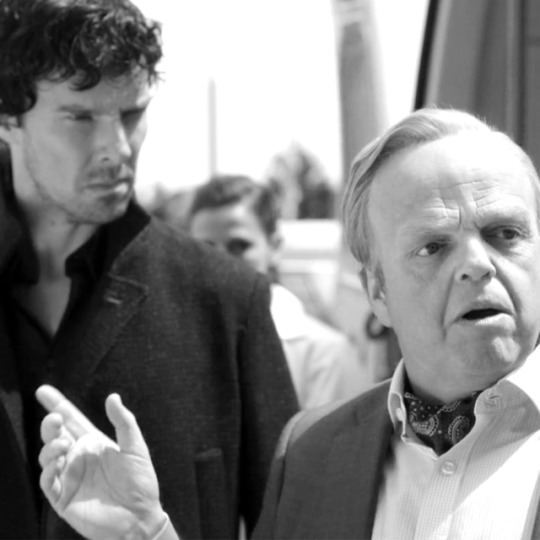




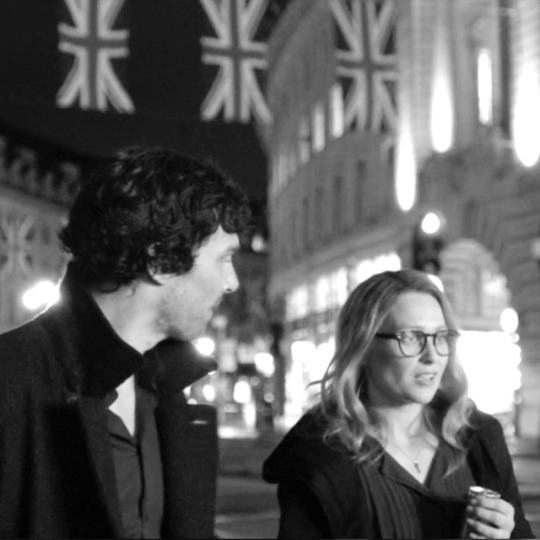

Maybe John can finally do some SELF REFLECTION in S5 and we can stop with all these freaking MIRRORS.
(Also, Eurus/Faith straight up SAID that like wtf)
#John Watson mirrors#johnlock#i will go down with this ship#mirrors#otp#faith smith#Culverton Smith#Molly hooper#the governor#eurus#vivian norbury#teh#tfp#tld#pining#sherlock loves john#meta#tfp meta#mirrors meta#Sherlock Holmes#john watson#save john watson
464 notes
·
View notes
Text
The Antagonistic Forces Of Johnlock
I was actually in the middle of writing another post when I realised there is a beautiful logic to the villains of Sherlock.
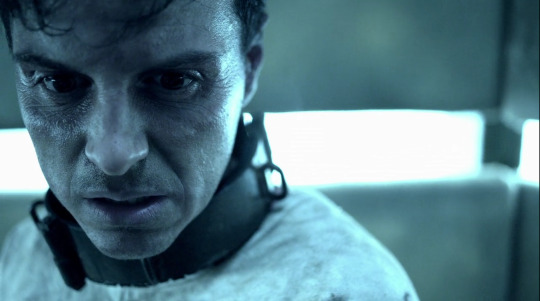
It’s not a new concept that Sherlock’s villains serve as mirrors for our main characters, and I love when I find good meta on this. But there is a pattern to these mirrors, that I think we have not talked about - and this is where it gets beautiful:
Each and every villain is designed to represent one of either John or Sherlock’s weaknesses. Weaknesses that either drive the two apart, or bring them closer to reaching one very specific common goal: love.
And there is a very simple way of telling which villain belongs to which category...
Sherlock And John’s Narrative Goals
In order to truly understand the antagonists of Sherlock, we must first have a look at what the show is actually about. Lesson one of story telling: protagonists usually have an extrinsic goal that moves a story forward, and a stronger, intrinsic goal that tends to get bullied in the pursuit of the extrinsic one. This absolutely holds true for Sherlock as well:

Sherlock’s extrinsic goal: catching criminals.
Sherlock’s intrinsic goal: love.
John’s extrinsic goal: making a contribution to society.
John’s intrinsic goal: also love.
Sherlock neglects his emotions and desires in order to be the very best consulting detective. But the underlying motivator for his actions is always the need to protect those he does love.
John being a man of ranks and uniforms, a man that is eager to please and to serve, he fears the social rejection that might come with admitting to his innermost desires, and he deeply struggles to emotionally connect with the people he loves (*cough* Sherlock).
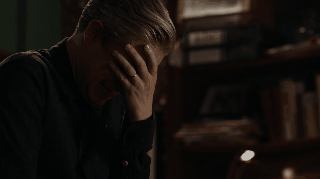
Both Sherlock’s drug addiction and John’s hunger for thrill are symptomatic for how much they deprive themselves of what they actually need.
Antagonistic Forces
So the story of Sherlock really is a quest for love. And the villains, in addition to being their brilliant villain selves, represent the antagonistic forces on that quest. Take Magnussen for instance: His weapon of choice being public denunciation, Magnussen represents fear of exposure and rejection, which is John’s biggest impediment.
And so it makes sense that it is John who falls victim to Magnussen right from the start. John gets burnt alive, John gets flicked in the face, and it is John’s wife who is threatened to be exposed. Interestingly though, it is Sherlock who flat out destroys Magnussen in the end. Magnussen’s power over John is literally all in his head and Sherlock is having none of it.
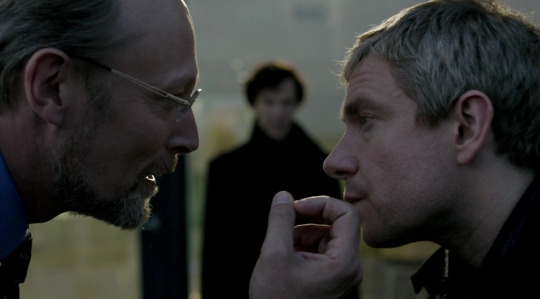
One of Sherlock’s own demons, on the other hand, keeps reappearing in the form of Moriarty. Moriarty is often seen as Sherlock’s evil side, but I think it is more than that: The constant boredom, the indifference to pain, and his attitude towards staying alive (”so boring, isn’t it?”) make me think that Moriarty represents depression.
And just like depression, Moriarty is ridiculously hard to beat. In fact, he doesn’t really get beaten, he just eventually stops of his own accord. All Sherlock can do is to survive him, and even that he can only pull off with the help of his brother. And finally, because depression never truly fully goes away, neither does Moriarty, who remains tucked away deep down in Sherlock’s mind palace even after his death. I really, really love all of this.
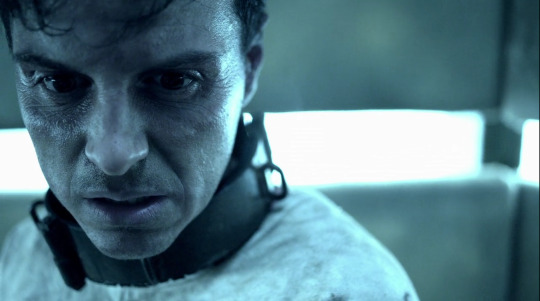
There is another villain who manages to shake Sherlock to the core and that is Culverton Smith, the “cereal killer”. His highly-polished “nice-guy” image is a cruel but accurate portrait of John and his compulsion to keep up appearances.
Smith is so popular that he can literally get away with murder. Similarly, John has become so good at putting up a facade, that we tend to overlook just how harmful this must be to anyone who tries to approach him. It is no wonder that Sherlock nearly falls victim to this particular villain and starts questioning his own judgement. Culverton Smith may represent a weakness of John’s, but he is most hurtful to Sherlock.

A War We Must Lose
You may have noticed that I haven’t talked about any female villains yet. There is a reason for that - and this is where my inner geek starts weeping for joy. I mentioned at the beginning of this post that there is a pattern to the antagonists. Well, here it is: While the male villains all represent forces that drive John and Sherlock away from love, the female villains do the exact opposite.
Female villains represent the forces that draw our protagonists towards each other. And if you have ever wondered what The Abominable Bride was about, this is your answer: “The women [..] we have lied to, betrayed; the women we have ignored and disparaged” they are demanding a vote. And it truly is a war that Sherlock and John must lose.
Take the famous Irene Adler, for instance, who is widely understood as the embodiment of Sherlock’s libido. No matter how hard Sherlock claims to be above such things, she is a clear match for him and Sherlock only just about beats her - for the time being.
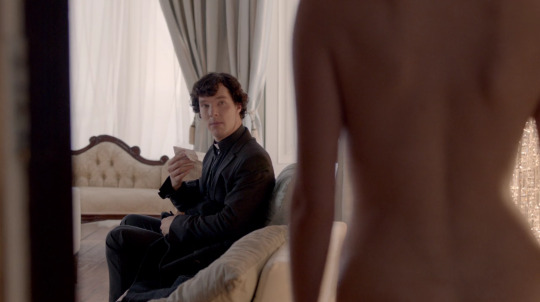
Or Mary, who is technically not a villain nor actually a mirror in the traditional sense. Rather she is a combination of both Sherlock and John. Clever and bad-ass like Sherlock, kind and caring like John, she is the best of both worlds and the connection between them when things become difficult. Mary represents the bond of friendship between the two.
And so it makes a lot of sense that Mary nearly kills Sherlock while at the same time she is saving his life. It is exactly what John’s friendship does to him: It nearly kills him, but it is also very much what keeps him going.
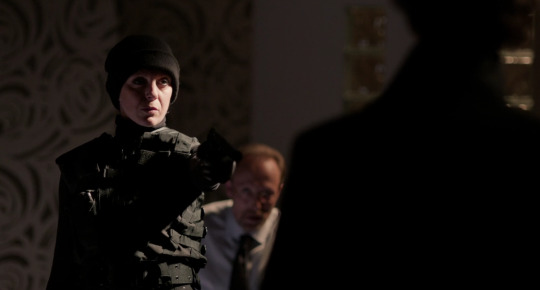
Oh, but of all those female villains, why then is Mary the one to die? If Mary represents Sherlock and John’s friendship - what in the world could possibly kill her?
The answer is: Vivian Norbury. Code word “Amo”. Latin for love. Nothing could kill the friendship of Sherlock Holmes and John Watson, except actual, proper, unadulterated love. John’s love, to be precise, what with her sweater vest and the tremor in her hand.
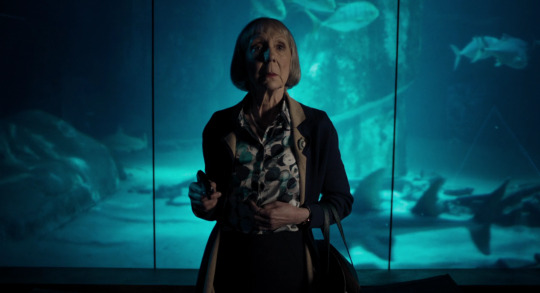
And I adore the idea of love being a bitter old cat lady. (Seriously, Gatiss.) Quietly biding her time, never noticed, never appreciated, fatally underestimated by Sherlock Holmes, she finally has had enough. Bugger the consequences if she can make an impression on the world’s most clueless consulting detective.
Do note at which point in the narrative this happens: John is utterly dissatisfied in his marriage and he is starting to want out. Even though Mary is the perfect woman for him, it is still not enough, he wants more and catches himself mentally cheating. And at that point, that old, quiet, neglected love finally stands up for itself. John has ignored it for way too long and there are no excuses left.
Except that this is the moment his wife dies and the guilt-ridden John can no longer stand to be around Sherlock. Anyone but him (read more about this here). And this is when Mary, aka their friendship, makes one last appearance: “John Watson, get the hell on with it.”
Save My Soul. Seek My Room.
For Sherlock, too, there is one more villain, one final problem that he has to overcome: His own mind in the form of Eurus. That genius, detached, over-analysing, and brilliant thing that is locked away in a high-security facility without human affection or physical contact.

What would happen, if those walls would suddenly crumble? Who would get hurt if Sherlock’s mind were allowed to wander freely?
But as it turns out, all Eurus - and therefore Sherlock’s mind - ever wanted in the first place was to be loved. There is no struggle between Sherlock’s heart and mind - they both want the same thing: human contact and affection. A co-pilot to help fly the plane. Sherlock only has to allow himself to have it.
#sherlock#sherlock meta#johnlock#pro moffat#pro gatiss#moriarty#eurus#culverton smith#irene adler#vivian norbury#I'm gonna start using this tag now#I LOVE THIS SO MUCH!!!!!#mofftiss rock#i'm gonna give this a#suicide tw#depression tw#long post#looooong post#my meta
243 notes
·
View notes